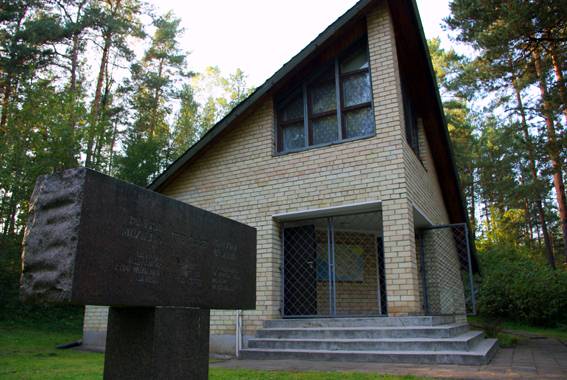Ponár (Polish Ponary, Lithuanian Paneriai) is the mass murder site outside Vilnius where around a hundred thousand civilians were murdered by the Nazi regime. Some 70,000 of them were the Jews of Vilna and its region.
Before the war the site was known as a bucolic holiday and picnic spot set in the forest. During the year-long Soviet rule in 1940-1941, large pits were dug for an oil storage facility. After the Nazi invasion the site was converted to a mass murder operation with the ready-dug pits serving as mass graves.
The vast majority of the murderers were local nationalist volunteers organized by the Nazis for the purpose of annihilating the country’s Jewish population. The eyewitness account of Christian Polish journalist Kazimierz Sakowicz was brought out in an academic English edition by Yale University Press in 2005 (Ponary Diary).
The small museum at the site has generally won acclaim for providing authentic information in a very small space and modest means. The primary address in Lithuania for visitors and locals wishing to learn more about the site is the Green House in central Vilnius.

It has been a stinging shock, however, that someone of the museum’s staff at Ponar has been switching posters there depending, it seems, on the anticipated visitors of the day. Ponár is around eight kilometers from Vilnius and does not attract many domestic visitors (one exception being Polish schools) outside of the annual September 23rd memorial ceremony, and the summertime visits of dedicated foreign visitors.
After repeated rumors and alleged sightings, one of the young former Holocaust volunteers from Austria’s Gedenkdienst, who had spent a year in Vilnius working at the Green House in Vilnius, wrote the following to DefendingHistory.com about his observations while in Vilnius in August 2010.
“I was at Ponár with two friends on a recent Sunday. The museum there was open and we went inside to see the exhibition which I had not seen again since the reopening a year beforehand.
“Looking at the panels, I noticed immediately that there are two panels about Lithuanian victims at Ponár, but was shocked to see that the Lithuanian Battalion called Ypatingasis būrys, that carried out most of the shootings, was not included! Instead, there was a panel at the end of the exhibition entitled ‘Murderers and Organizers of Paneriai’ with a list of names, including all the German officials, and as I read the lists of names, I saw the name of Jakob Gens, head of the Jewish ghetto police, among them. I found it an outrage to mention Jakob Gens, the head of the Judenrat — although he is a deeply controversial figure of course — among those of the German officials. But no member of the Ypatingasis būrysis mentioned. No Šidlauskas, no Lukošius, no Jonas Tuminas, no Lileikis or Novaiša. Same goes for the Khapúnes (‘catchers’) of Jews in the early weeks after the German invasion or any of the other groups of Lithuanian participants.
“To make the Jews themselves collaborators instead of the ones responsible for the Holocaust is probably the most antisemitic revisionism you could in your life imagine, specially if you completely omit the real local collaborators and participants in the genocide, in other words the actual killers. “So in my anger I went to the historian who works at the museum in Ponár and complained. His answer was: ‘You have no clue about history.’
“The next day, I went to museum officials in Vilnius and told them the story, and it turned out that the panel with Jakob Gens on it was the old panel made by the Ponár museum historian himself and it had been taken down during renovation and replaced with a new museum panel that duly mentions the local Lithuanian collaborators (and not Gens) among the perpetrators, as part of a coherent professionally constructed text.
“Then the historian stationed at Ponár took off the panel and installed again the other one, without mentioning anything to museum officials in Vilnius. The next day, a colleague went to Ponár to talk with the historian and suddenly the respectable and historically accurate new museum panel, that Vilnius museum staff compiled for the renovated exhibit, was there once again. So the historian must have thought that I will not keep silent and replaced it again with the official one.”

